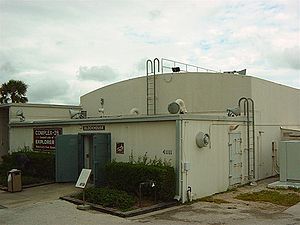
Cape Canaveral Air Force Station Launch Complex 26
Encyclopedia

Cape Canaveral Air Force Station
Cape Canaveral Air Force Station is an installation of the United States Air Force Space Command's 45th Space Wing, headquartered at nearby Patrick Air Force Base. Located on Cape Canaveral in the state of Florida, CCAFS is the primary launch head of America's Eastern Range with four launch pads...
, Florida
Florida
Florida is a state in the southeastern United States, located on the nation's Atlantic and Gulf coasts. It is bordered to the west by the Gulf of Mexico, to the north by Alabama and Georgia and to the east by the Atlantic Ocean. With a population of 18,801,310 as measured by the 2010 census, it...
. LC-26 consisted of two pads, A and B. Pad A was used for the Jupiter-C
Jupiter-C
The Jupiter-C was an American sounding rocket used for three sub-orbital spaceflights in 1956 and 1957 to test re-entry nosecones that were later to be deployed on the more advanced PGM-19 Jupiter mobile missile....
and Juno I
Juno I
The Juno I was a four-stage American booster rocket which launched America's first satellite, Explorer 1, in 1958. A member of the Redstone rocket family, it was derived from the Jupiter-C sounding rocket...
rockets, and was the launch site for Explorer 1, the United States
United States
The United States of America is a federal constitutional republic comprising fifty states and a federal district...
' first satellite, in 1958. Pad B was used for Juno II
Juno II
Juno II was an American space launch vehicle used during the late 1950s and early 1960s. It was derived from the Jupiter missile, which was used as the first stage.-Development:...
. Jupiter IRBMs were launched from both pads.
In its early years, it was used to launch ballistic missiles on test flights, and could have been used for a nuclear strike against the Soviet Union
Soviet Union
The Soviet Union , officially the Union of Soviet Socialist Republics , was a constitutionally socialist state that existed in Eurasia between 1922 and 1991....
if nuclear war
Nuclear warfare
Nuclear warfare, or atomic warfare, is a military conflict or political strategy in which nuclear weaponry is detonated on an opponent. Compared to conventional warfare, nuclear warfare can be vastly more destructive in range and extent of damage...
had begun.
On February 1, 1958 (January 31 local time), the US Army Ballistic Missile Agency
Army Ballistic Missile Agency
The Army Ballistic Missile Agency was the agency formed to develop the US Army's first intermediate range ballistic missile. It was established at Redstone Arsenal on February 1, 1956 and commanded by Major General John B...
launched Explorer 1 from LC-26A.
LC-26 is also the home of the Air Force Space & Missile Museum
Air Force Space & Missile Museum
The Air Force Space & Missile Museum is located at Launch Complex 26 at Cape Canaveral Air Force Station, Florida. It includes artifacts from the early American space program and includes an outdoor rocket garden displaying rockets, missiles and space-related equipment chronicling the US Air...
. Access to the museum at LC-26 as well as the adjoining LC-5
Cape Canaveral Air Force Station Launch Complex 5
Launch Complex 5 was a launch site at Cape Canaveral Air Force Station, Florida used for various Redstone and Jupiter launches.It is most well known as the launch site for NASA's 1961 suborbital Mercury-Redstone 3 flight, which made Alan Shepard the first American in space. It was also the launch...
and LC-6
Cape Canaveral Air Force Station Launch Complex 6
Launch Complex 6 at Cape Canaveral Air Force Station, Florida is a launch site used by Redstone and Jupiter series rockets and missiles. It is on the south end of Cape Canaveral, close to Launch Complex 5, with which it shared a blockhouse. With LC-5, it was the location of the first tests of the...
by the general public can be arranged through the Kennedy Space Center
Kennedy Space Center
The John F. Kennedy Space Center is the NASA installation that has been the launch site for every United States human space flight since 1968. Although such flights are currently on hiatus, KSC continues to manage and operate unmanned rocket launch facilities for America's civilian space program...
Visitor Center "Cape Canaveral: Then and Now Tour". The Cape Canaveral Air Force Station also offers monthly tours.
See also
- List of Cape Canaveral and Merritt Island launch sites
- Jupiter IRBM
- Jupiter-CJupiter-CThe Jupiter-C was an American sounding rocket used for three sub-orbital spaceflights in 1956 and 1957 to test re-entry nosecones that were later to be deployed on the more advanced PGM-19 Jupiter mobile missile....

